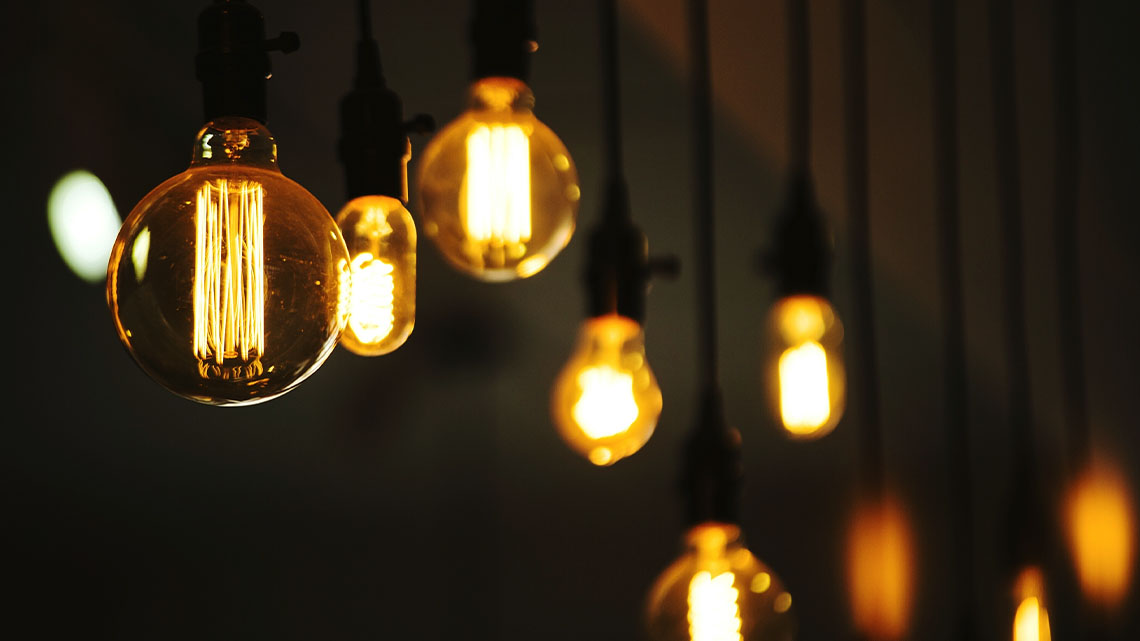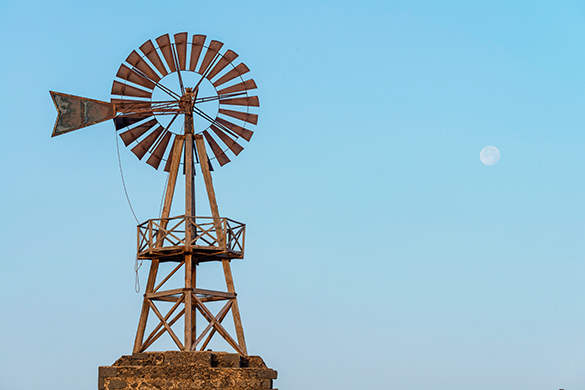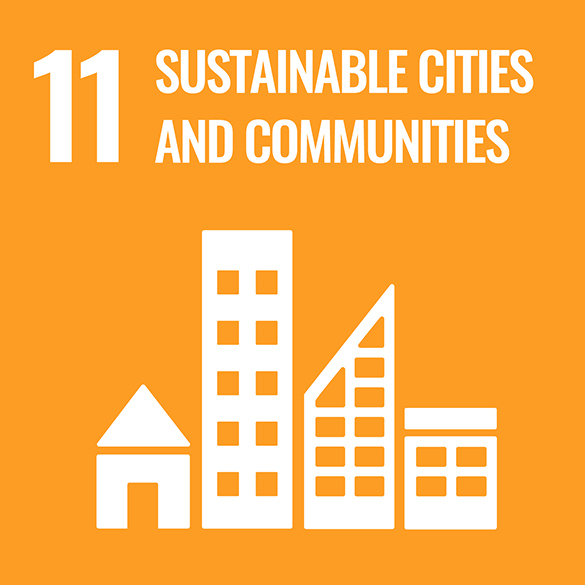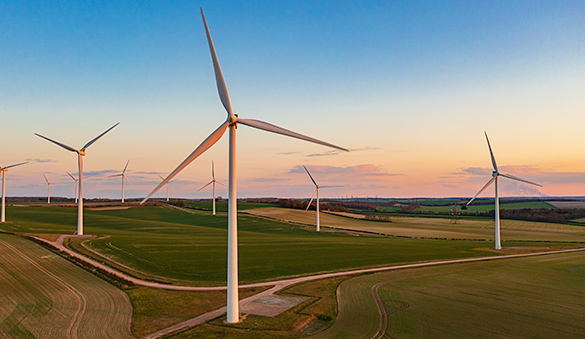Minds On
Renewable energy

What is energy used for? Where does it come from?
Sources of energy can be either renewable or non-renewable.
- Renewable energy is an energy source that can be replenished by natural processes.
- Non-renewable energy is an energy source that is finite and cannot be renewed naturally.
Action
Why go renewable?

The wind, the sun, and the Earth are all sources of renewable energy because they will naturally renew or replenish themselves.
Renewable energy is generally at the top of the list for changes that the world can make to try to combat the rising temperatures on Earth. Many renewable energy sources do not emit carbon dioxide and other greenhouse gases that negatively impact the environment.
Did You Know?
Did you know?
For many years, humans have relied heavily on non-renewable energy sources such as coal, oil and other fossil fuels. These sources have increased greenhouse gas emissions over time, so populations are now exploring the possibility of using more renewable sources of energy to power cities and communities more sustainably.
Along with new technologies that are being invented for renewable energy sources, STEM careers are expanding and developing in fields connected to renewable energy.
For example, consider the development of wind turbines. They require engineers who have specific skills to design, build, maintain, and manage wind farms around the world.
Press ‘Hint’ to access additional details.
- STEM is an acronym that broadly stands for the four academic fields of science, technology, engineering, and math.
- A wind turbine is a machine that transforms wind energy into electricity using the aerodynamic force from the rotating blades.
Wind turbines
Check out this video entitled “London Array Wind Farm” to learn more about wind turbines and wind farms. As you are exploring, notice different people, roles, places, and important details.
Record your notes in a notebook or another method of your choice.
Student Success
Think!
If possible, with a partner, reflect and respond to the following prompts:
- What challenges were experienced when building the London Array wind farm?
- How have wind turbines changed and developed over time?
Record your thoughts in a notebook or another method of your choice.
If possible, share your thoughts and responses with a partner.
When you’re ready, press ‘Let’s Check!’ to access sample responses.
1. What challenges were experienced when building the London Array wind farm?
Some challenges were: the environment is unpredictable, there are a lot of changes in tidal waves so there are high currents, the wind turbines are far away from other amenities if they need specific tools to be fixed, etc.
2. How have wind turbines changed and developed over time?
Originally windmills had large sails and were used to power irrigation pumps in 200 BC in China. A wind wheel organ was first designed and powered by wind. Vertical windmills with sails were used by crusaders. They were originally used to grind food, but eventually someone realized it could do a lot more. The world’s first wind turbine was built in 1887 to power the lights in a cottage, and it was eventually used in a hospital to provide reliable electricity.
Note to teachers: See your teacher guide for collaboration tools, ideas and suggestions.
History

Originally a wind turbine was called a “wind wheel” and it was used to grind corn and flour, pump water, and power a machine.
- In 1887, the first known wind turbine was used to produce electricity and provide power to a house in Scotland.
- In 1891, it was designed to supply a steady stream of power, and by 1895, a prototype was developed for an electrical power plant.
- By 1975, major research projects were being funded by NASA, and a large-scale wind farm was developed to provide power for over 4000 homes. From here, this technology kept developing the capability to produce more power.
Global connection

The United Nations (UN) is a group of many countries from around the world that have come together to create a better future for people and the environment. They have created 17 goals called the Sustainable Development Goals.
This learning activity is connected to Goal #11: Sustainable Cities and Communities. This means that our cities and communities should be inclusive, safe, resilient, and sustainable. Communities that are not sustainable can lead to pollution, unrest, insecurity, lack of economic growth, and more.
Sustainable energy options

Renewable energy options, such as wind farms, support sustainability and have positive (and some negative) social, economic, and environmental impacts.
Across Canada, First Nations communities are exploring renewable energy as a cleaner, cheaper, and self-sustaining alternative to power.
For example, on the island of Haida Gwaii, located in British Columbia, the Haida Nation is exploring a combination of wind and solar energy to meet its current and future needs. This project calls for 110 wind turbines to be built for local use. This initiative hopes to counter the impact of climate change on their food and water systems, which was partly due to the carbon emissions in the air. This project will use wind and solar energy, instead of using fossil fuels as they had in the past.
Pause and Reflect
Pause and reflect
How will the Haida nation help combat the impact of climate change on their island?
Record your ideas in a notebook or another method of your choice.
Press ‘Let’s Check!’ to access a correct response.
By turning to solar and wind energy, the Haida Nation will no longer have to rely on fossil fuels, and they can provide cleaner energy for their current and future communities.
The impacts of energy use

Because a higher population of humans increases the demand for electricity, finding sustainable and renewable energy sources is a high priority for cities and communities.
Urban developers must consider the potential social, economic, or environmental impacts of the source when determining the most appropriate type of renewable energy.
Check out the following impacts:
- Social impacts: How will it affect people’s lives, housing, food, water, and basic necessities?
- Economic impacts: How will it affect people’s jobs and income, or the community?
- Environmental impacts: How will it affect the natural environment?
Let’s consider the wind turbines again. While they are widely known as a renewable source of energy, wind farms introduce various social, economic, and environmental impacts and costs.
Explore the Assessing the Impacts of Wind Turbines for examples of these different impacts, costs, and benefits.
|
Impact |
Description of impact |
|---|---|
Social |
|
Economic |
|
Environmental |
|
Costs |
|
Benefits |
|
Press the ‘Activity’ button to access Assessing the Impacts of Wind Turbines.
Renewable sources
There are many different sustainable and innovative energy options around the world; wind farms are only one example.
Let’s explore the following examples of innovative, sustainable, renewable energy options.
Press the following tabs to access the renewable energy sources.

Geothermal energy can melt underground rocks into magma and cause magma to bubble to the surface as lava. Geothermal energy heats up underground sources of water and forces out streams of water called “geysers.” Geothermal heat pumps are one way to access geothermal energy. They can be used to heat houses, sidewalks, and even parking lots. Geothermal energy can also use steam to turn a generator and create electricity.

Biomass energy is any material that comes from plants, food waste, or microorganisms, such as trees, branches, bark or recycled paper. We can get energy from biomass by burning it, which is then used to create heat or generate electricity.

Hydroelectric energy is made by flowing water, such as a dam on a river. A controlled amount of water flows through tunnels and turns huge turbines and generates electricity.

Solar energy uses the sun’s rays to generate electricity, which can be used to create heat, power lights, and much more.
Now, let’s choose two of the energy sources we previously explored to research in further detail.
Consider the following for both energy sources:
- Social impacts: How will it affect people’s lives, housing, food, water, and basic necessities?
- Economic impacts: How will it affect people’s jobs and income, or the community?
- Environmental impacts: How will it affect the natural environment?
- Costs and benefits?
Complete the Impacts of Energy Sources Activity in your notebook or using the following fillable and printable document. If you would like, you can use speech-to-text or audio recording tools to record your thoughts.
|
Description of impact |
||
|---|---|---|
|
Impacts |
Source A: |
Source B: |
Social |
||
Economic |
||
Environmental |
||
Costs and Benefits |
||
Press the ‘Activity’ button to access Impacts of Energy Sources Activity.
You may also use the following checklists to guide your independent research:
When choosing a source…
For individual sources, consider the following:
Designing a sustainable device
Consider the ways that cities and communities around the world are harnessing different forms of renewable energy. Imagine you have been hired by a city planner from a developing community to determine which type of renewable energy to use in this new neighbourhood.
Your task is to design a device that uses renewable energy and is socially, economically, and environmentally beneficial and sustainable. As well, you will try to convince an audience that your design is a sustainable source of energy.
Earlier we explored the role of a wind turbine engineer working at the London Array Wind Farm, and some of the considerations they would make during the design process.
To complete this task, check out this video to learn about the steps of the Engineering Design Process.
Complete the Renewable Engineering Design Activity in your notebook or using the following fillable and printable document. If you would like, you can use speech-to-text or audio recording tools to record your thoughts.
|
1. Initiating and planning |
Record/describe your ideas |
|
Research and identify the problem:
|
|
|
2. Performing and recording |
Draw/describe your prototype |
|
Select an option and develop a prototype:
|
|
|
3. Test the prototype |
Record your observations |
|
Select an option:
|
|
|
4. Analyzing and interpreting |
Concerns/possible changes |
|
Evaluate and revise the prototype:
|
|
|
5. Communicating |
Share your final design |
|
Communicate the solution:
|
Press the ‘Activity’ button to access Renewable Engineering Design Activity.
Consolidation
Share your learning

After exploring and investigating energy sources throughout this learning activity, choose one of the following tasks to demonstrate your learning.
Press the following tabs to access each learning task.
In this learning activity, you have explored several different renewable energy sources and assessed how renewable energy is sustainable.
Choose one of the following scenarios that interests you:
- A school is building a new library and they are exploring heating options with renewable energy sources. Make a case for or against installing a geothermal heat pump or solar panels. Be sure to consider all of the stakeholders that are involved (i.e., the children at the school, the engineer, the staff, the community, the budget holders, etc.).
- A community is debating whether or not they should use rural land for wind turbines to provide energy to the community. Make a case for or against building the wind farm near your community. Be sure to consider all of the stakeholders that are involved (i.e., those who live in the community, those who live in the rural area, the engineer building them, etc.).
After choosing a scenario, create a paragraph explaining your opinion. Be sure to include specific details to support your opinion.
Record your opinions and paragraph in a notebook or another method of your choice.
Let’s educate others by raising awareness on renewable energy sources in your community. Consider which options might be accessible to the community, and how you might use this method of promotion to explain the difference between renewable and non-renewable energy.
Then, choose one of the following methods to share your learning:
- website
- social media post
- podcast
- poster
- or another method of your choice
For either task, you may use the following checklist to guide your thinking:
Pause and Reflect
Pause and reflect
Let’s reflect and respond to the following questions:
- What step did you enjoy the most about designing a renewable source of energy? Why?
- Which energy source that you investigated in this learning activity do you feel could have the biggest impact on the future? Why?
- What do you think the impact of this technology will have on everyday life?
Record your thoughts and ideas in a notebook or another method of your choice.
Reflection
As you read the following descriptions, select the one that best describes your current understanding of the learning in this activity. Press the corresponding button once you have made your choice.
I feel…
Now, expand on your ideas by recording your thoughts using a voice recorder, speech-to-text, or writing tool.
When you review your notes on this learning activity later, reflect on whether you would select a different description based on your further review of the material in this learning activity.